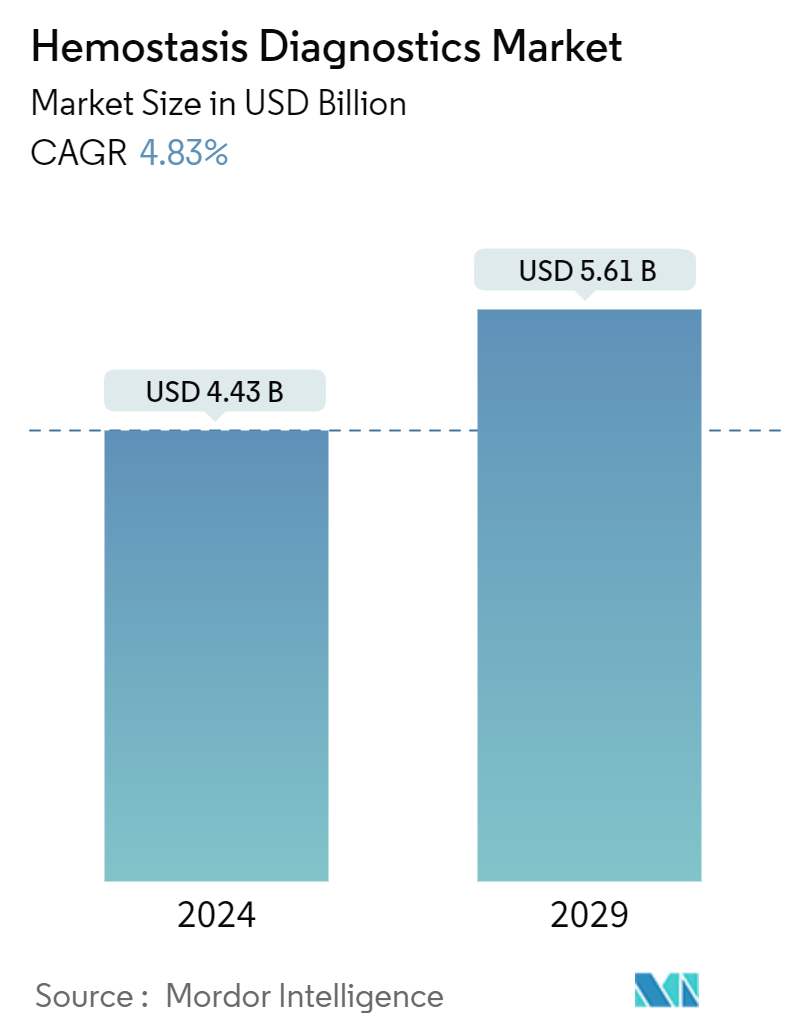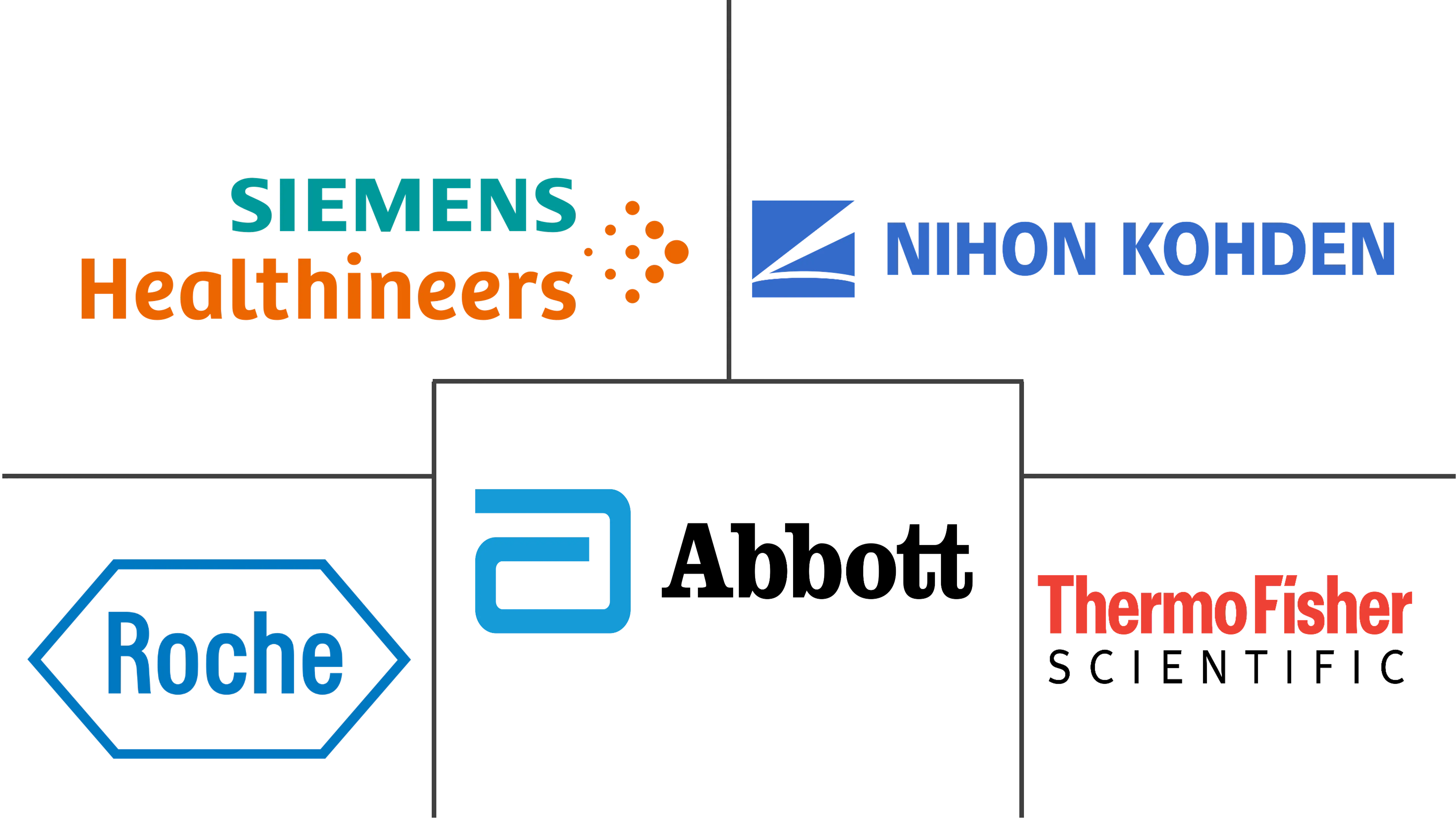Market Size of Hemostasis Diagnostics Industry

| Study Period | 2019 - 2029 |
| Market Size (2024) | USD 4.43 Billion |
| Market Size (2029) | USD 5.61 Billion |
| CAGR (2024 - 2029) | 4.83 % |
| Fastest Growing Market | Asia Pacific |
| Largest Market | North America |
| Market Concentration | Low |
Major Players
*Disclaimer: Major Players sorted in no particular order |
Hemostasis Diagnostics Market Analysis
The Hemostasis Diagnostics Market size is estimated at USD 4.43 billion in 2024, and is expected to reach USD 5.61 billion by 2029, at a CAGR of 4.83% during the forecast period (2024-2029).
The rising incidences of bleeding and blood-related disorders, technological advancements in diagnostics, and rising adoption of automated hemostasis equipment are projected to drive the global hemostasis diagnostics market. The surge in awareness about thrombosis and coagulation disorders, growing demand for precision diagnostics, and introduction of advanced diagnostics platforms are further projected to support market growth.
- The rising prevalence of bleeding disorders, such as hemophilia and von Willebrand disease, has heightened the demand for accurate and efficient hemostasis testing. Early detection and management of these conditions are critical, driving the need for advanced diagnostic solutions.
- The notable disease burden of hemophilia is projected to offer growth opportunities for the market. For instance, according to the 2024 updated data of the National Bleeding Disorders Foundation, around 12 in 100,000 people are affected with hemophilia in the United States and around 400 children are born with this condition every year. Such a high burden of hemophilia is anticipated to bolster demand for hemostasis diagnostics to detect bleeding issues and accelerate market growth over the coming years.
- According to September 2024 data from the Hemophilia Foundation, bleeding disorders are life-threatening disorders in Australia, affecting around 7,400 people yearly. Hence, such a remarkable disease burden is projected to drive the demand for hemostasis diagnostics to provide reliable diagnosis, and this trend is expected to fuel market growth over the study period.
- Advancements in hemostasis testing technologies, such as point-of-care testing and automated analyzers, have improved the speed and accuracy of diagnostic results. These advancements make it easier for healthcare providers to perform tests and interpret results, expanding the market.
- For instance, several advantages associated with hematology tests, such as reduced turnaround time and improved accuracy, have improved their roles in critical care settings. According to an article published in Intensive Care Medicine in May 2024, hemostasis testing with platelet function testing, plasmin-antiplasmin complex (PAP) D-dimer testing, and antithrombin activity testing empowered clinicians to improve clinical outcomes in patients in critical care settings. Hence, such benefits of hemostasis testing are expected to accelerate their adoption rate over the study period.
- Various strategic agreements and collaborations undertaken by market players to strengthen the arena of hemostasis diagnostics products and consumables are further projected to offer potential growth opportunities for market growth. For instance, in March 2023, Sysmex Corporation signed a global OEM agreement with Siemens Healthcare Diagnostics Inc. focused on hemostasis products. Under this agreement, both companies were to supply each other with their respective diagnostic products in the hemostasis field on an OEM basis. Therefore, such strategic agreements undertaken by market players are expected to offer significant growth opportunities.
- Given these dynamics, including the global prevalence of hemophilia, ongoing research in hemostasis diagnostics, and proactive strategies by market players, the market is poised for notable growth. Yet, challenges like limited awareness of hemostasis disorders in developing regions and stringent government regulations are expected to hinder market expansion.
Hemostasis Diagnostics Industry Segmentation
As per the scope of the report, hemostasis diagnostics are devices that help identify hemostatic defects that lead to excessive bleeding. Hemostasis is a mechanism followed by the body after getting injured. It slows down blood loss and stops blood flow. Hemostasis helps diagnose the actual cause of these disorders with history and helps in the treatment.
The hemostasis diagnostics market is segmented by product, test, end-use, and geography. By product, the market is segmented as laboratory analyzers and point-of-care testing systems. By test, the market is segmented into activated partial thromboplastin time, D-dimer test, fibrinogen test, prothrombin time (PT) test, and other tests. By end user, the market is segmented into hospitals, diagnostic centers, and other end users. The market is segmented by geography, such as North America, Europe, Asia Pacific, Middle East and Africa, and South America. The report also covers the market sizes and forecasts for the hemostasis diagnostics market in major countries across different regions. The report offers the market size in value terms in USD for all the abovementioned segments.
| By Product | |||||
| |||||
| Point-of-Care Testing Systems |
| By Test | |
| Activated Partial Thromboplastin Time | |
| D-Dimer Test | |
| Fibrinogen Test | |
| Prothrombin Time (PT) Test | |
| Other Tests (Thrombin Time and Clotting Factor Assays) |
| By End User | |
| Hospitals | |
| Diagnostic Centers | |
| Other End Users (Outpatient Clinics and Blood Banks) |
| Geography | ||||||||
| ||||||||
| ||||||||
| ||||||||
| ||||||||
|
Hemostasis Diagnostics Market Size Summary
The hemostasis diagnostics market is poised for significant growth, driven by a combination of factors including the increasing prevalence of blood clotting disorders and the rising number of surgical procedures necessitating routine preoperative assessments. The market's expansion is further supported by technological advancements in medical treatments and the growing adoption of automated hemostasis equipment. The COVID-19 pandemic highlighted the critical role of hemostasis diagnostics, particularly in patients with comorbidities such as diabetes and cardiovascular diseases, thereby boosting the market's utility. The demand for point-of-care testing, which offers rapid and reliable diagnostic results, is also on the rise, especially in emergency and intensive care settings. Strategic initiatives by key market players, including partnerships and product launches, are contributing to the market's robust growth trajectory.
North America is expected to maintain a significant share of the hemostasis diagnostics market, driven by the high adoption of advanced automated analyzers and a large patient pool with a high prevalence of blood clot disorders. The region benefits from collaborations between government organizations and market players, which are fostering research and development in hemophilia diagnostics. The competitive landscape is characterized by the presence of both international and regional companies, with major players like Abbott, Sysmex Corporation, and Thermo Fisher Scientific Inc. actively participating in the market. Recent advancements, such as the FDA clearance of innovative hemostasis systems, underscore the ongoing technological progress and strategic efforts to enhance market position and growth.
Hemostasis Diagnostics Market Size - Table of Contents
-
1. MARKET DYNAMICS
-
1.1 Market Overview
-
1.2 Market Drivers
-
1.2.1 Rising Incidences of Bleeding Disorders
-
1.2.2 Technological Advancements for Medical Treatment
-
1.2.3 Rising Adoption of Automated Hemostasis Equipment
-
-
1.3 Market Restraints
-
1.3.1 Lack of Awareness in Developing Countries
-
1.3.2 Stringent Government Regulation
-
-
1.4 Porter's Five Force Analysis
-
1.4.1 Threat of New Entrants
-
1.4.2 Bargaining Power of Buyers/Consumers
-
1.4.3 Bargaining Power of Suppliers
-
1.4.4 Threat of Substitute Products
-
1.4.5 Intensity of Competitive Rivalry
-
-
-
2. MARKET SEGMENTATION (Market Size by Value - USD)
-
2.1 By Product
-
2.1.1 Laboratory Analyzers
-
2.1.1.1 Automated Systems
-
2.1.1.2 Semi-automated Systems
-
2.1.1.3 Manual Systems
-
-
2.1.2 Point-of-Care Testing Systems
-
-
2.2 By Test
-
2.2.1 Activated Partial Thromboplastin Time
-
2.2.2 D-Dimer Test
-
2.2.3 Fibrinogen Test
-
2.2.4 Prothrombin Time (PT) Test
-
2.2.5 Other Tests (Thrombin Time and Clotting Factor Assays)
-
-
2.3 By End User
-
2.3.1 Hospitals
-
2.3.2 Diagnostic Centers
-
2.3.3 Other End Users (Outpatient Clinics and Blood Banks)
-
-
2.4 Geography
-
2.4.1 North America
-
2.4.1.1 United States
-
2.4.1.2 Canada
-
2.4.1.3 Mexico
-
-
2.4.2 Europe
-
2.4.2.1 Germany
-
2.4.2.2 United Kingdom
-
2.4.2.3 France
-
2.4.2.4 Italy
-
2.4.2.5 Spain
-
2.4.2.6 Rest of Europe
-
-
2.4.3 Asia-Pacific
-
2.4.3.1 China
-
2.4.3.2 Japan
-
2.4.3.3 India
-
2.4.3.4 Australia
-
2.4.3.5 South Korea
-
2.4.3.6 Rest of Asia-Pacific
-
-
2.4.4 Middle East and Africa
-
2.4.4.1 GCC
-
2.4.4.2 South Africa
-
2.4.4.3 Rest of Middle East and Africa
-
-
2.4.5 South America
-
2.4.5.1 Brazil
-
2.4.5.2 Argentina
-
2.4.5.3 Rest of South America
-
-
-
Hemostasis Diagnostics Market Size FAQs
How big is the Hemostasis Diagnostics Market?
The Hemostasis Diagnostics Market size is expected to reach USD 4.43 billion in 2024 and grow at a CAGR of 4.83% to reach USD 5.61 billion by 2029.
What is the current Hemostasis Diagnostics Market size?
In 2024, the Hemostasis Diagnostics Market size is expected to reach USD 4.43 billion.

